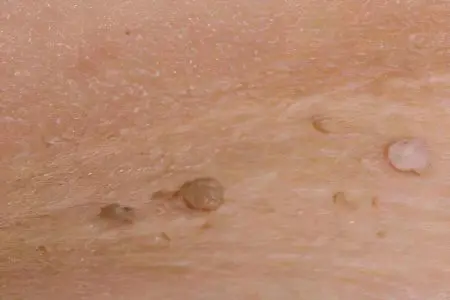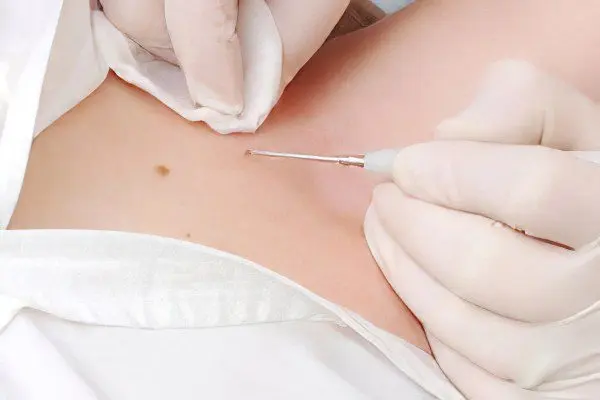Contents

Fibroma of the skin called a benign neoplasm, consisting of mature elements of connective tissue. Its appearance resembles a dense formation. Fibroma has clear boundaries, and may not differ in color from the skin or have a light pink tint. In a large number of cases, the skin under the neoplasm does not change either in structure or in color. As a rule, only with large sizes, the tumor acquires a reddish-bluish color. Often fibroma has a mushroom shape or has a leg.
The distinguishing features of fibroma include slow development. This formation occurs with the same frequency both on the mucous membranes of the internal organs and the oral cavity, and on ordinary skin areas. In women, ovarian and uterine fibroids are most common, but breast fibroids also occur. As a rule, this neoplasm is not prone to transition to a malignant tumor.
Types of skin fibroma
There are two types of fibroma. The first of these is a hard fibroma of the skin. In most cases, such a neoplasm is located on a wide base, but sometimes a solid skin fibroma has a leg. To the touch it is dense, limited mobility. This type of fibroma can form both on the skin and on the mucous membranes. The probability of formation of a hard fibroma in women and men is the same. The second variety is called soft fibroma. Its characteristic difference is its appearance.
A soft fibroma of the skin looks like a small wrinkled pouch on a leg. In most cases, the formation of a soft fibroma affects women in adulthood. This neoplasm most often appears on the anterior surface of the neck, inguinal folds, in the armpits, on the chest and on the skin folds under the mammary glands.
Causes of skin fibroids
Fibroids occur in people of various age categories. The true cause of the disease is not yet known, but some experts point to its hereditary nature or associate it with the aging process of the skin. An inflammatory disease or injury can also lead to the formation of a fibroma. In addition, diabetes mellitus, endocrine disruptions in the body, and acromegaly can provoke such a neoplasm. Pregnancy also contributes to the growth of fibroids due to an increase in female hormones in the body.
Skin fibroma symptoms
Fibroma of the skin rarely causes specific symptoms. In the event of various growths on the skin, you should immediately consult a doctor. Signs of a skin fibroma include: typically a reddish-brown color that may change over time, small size, tenderness or itching when touched, and bleeding if injured. The diagnosis of the disease is established by the doctor as a result of a visual examination. The doctor performs a physical examination and asks about the history and symptoms of a skin fibroma.
Diagnostics
Diagnosis of skin fibroids is carried out by sight and touch. The doctor can compress the skin in the area of the neoplasm, after compression a dimple is formed. If there are doubts about the good quality of the fibroma, then it can be eliminated surgically. After that, the removed tissue is sent for histological examination.
Skin fibroids can have some complications. It can be injured by a blade during shaving or by various items of clothing, perhaps its spontaneous twisting, as a result of which the blood supply to the fibroma tissue deteriorates. In this case, there is pain, necrosis (necrosis), swelling and possibly the addition of a secondary infection.
Skin fibroma treatment

Fibroma is treated surgically. It is removed if it has a bright cosmetic defect or is regularly injured (with a blade during shaving, a strap of clothing or a belt due to its location in certain anatomical areas). In certain cases, such traumatization can provoke the unfavorable development of the tumor and the resumption of its growth. Removal of fibroma surgically is carried out, as a rule, in a polyclinic under local infiltration anesthesia.
Such surgery is performed in several ways: electrocoagulation, radio wave method, using a laser, traditional surgical excision with a scalpel. The most preferred and modern methods in our time are considered to be radio wave and laser elimination of fibroids. These methods allow this operation to be carried out almost bloodlessly. Timely and correct treatment gives great chances for a favorable prognosis. In about 95% of cases, it is possible to achieve a complete cure for the neoplasm.
In the future, relapses of the disease are possible, but, as a rule, they do not occur after radio wave and laser removal.









